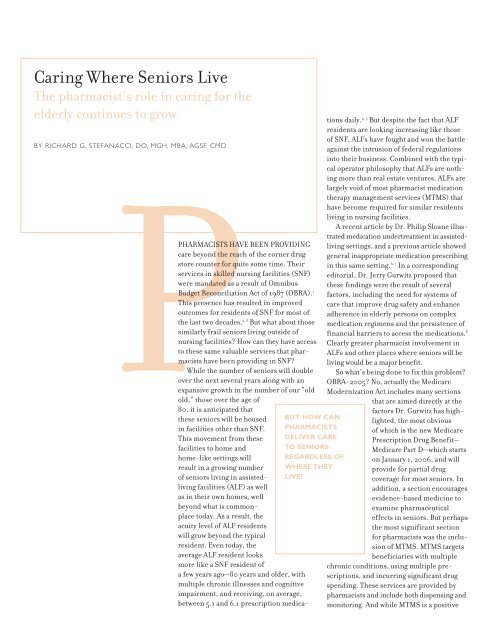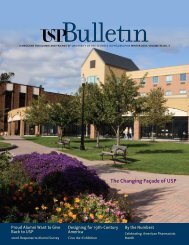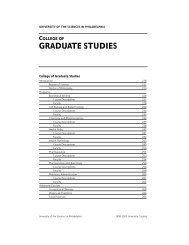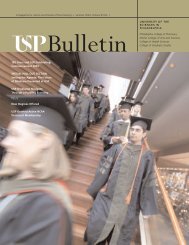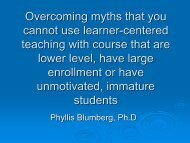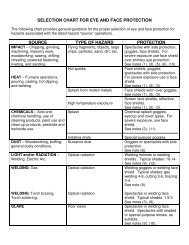Car<strong>in</strong>g Where Seniors LiveThe pharmacist’s role <strong>in</strong> car<strong>in</strong>g for <strong>the</strong>elderly cont<strong>in</strong>ues to growBY RICHARD G. STEFANACCI, DO, MGH, MBA, AGSF, CMDPHARMACISTS HAVE BEEN PROVIDINGcare beyond <strong>the</strong> reach <strong>of</strong> <strong>the</strong> corner drugstore counter for quite some time. Theirservices <strong>in</strong> skilled nurs<strong>in</strong>g facilities (SNF)were mandated as a result <strong>of</strong> OmnibusBudget Reconciliation Act <strong>of</strong> 1987 (OBRA). 1This presence has resulted <strong>in</strong> improvedoutcomes for residents <strong>of</strong> SNF for most <strong>of</strong><strong>the</strong> last two decades. 2, 3 But what about thosesimilarly frail seniors liv<strong>in</strong>g outside <strong>of</strong>nurs<strong>in</strong>g facilities? How can <strong>the</strong>y have accessto <strong>the</strong>se same valuable services that pharmacistshave been provid<strong>in</strong>g <strong>in</strong> SNF?While <strong>the</strong> number <strong>of</strong> seniors will doubleover <strong>the</strong> next several years along with anexpansive growth <strong>in</strong> <strong>the</strong> number <strong>of</strong> our “oldold,” those over <strong>the</strong> age <strong>of</strong>80, it is anticipated that<strong>the</strong>se seniors will be housed<strong>in</strong> facilities o<strong>the</strong>r than SNF.This movement from <strong>the</strong>sefacilities to home andhome-like sett<strong>in</strong>gs willresult <strong>in</strong> a grow<strong>in</strong>g number<strong>of</strong> seniors liv<strong>in</strong>g <strong>in</strong> assistedliv<strong>in</strong>gfacilities (ALF) as wellas <strong>in</strong> <strong>the</strong>ir own homes, wellbeyond what is commonplacetoday. As a result, <strong>the</strong>acuity level <strong>of</strong> ALF residentswill grow beyond <strong>the</strong> typicalresident. Even today, <strong>the</strong>average ALF resident looksmore like a SNF resident <strong>of</strong>a few years ago—80 years and older, withmultiple chronic illnesses and cognitiveimpairment, and receiv<strong>in</strong>g, on average,between 5.1 and 6.1 prescription medica-BUT HOW CANPHARMACISTSDELIVER CARETO SENIORSREGARDLESS OFWHERE THEYLIVE?tions daily. 4, 5 But despite <strong>the</strong> fact that ALFresidents are look<strong>in</strong>g <strong>in</strong>creas<strong>in</strong>g like those<strong>of</strong> SNF, ALFs have fought and won <strong>the</strong> battleaga<strong>in</strong>st <strong>the</strong> <strong>in</strong>trusion <strong>of</strong> federal regulations<strong>in</strong>to <strong>the</strong>ir bus<strong>in</strong>ess. Comb<strong>in</strong>ed with <strong>the</strong> typicaloperator philosophy that ALFs are noth<strong>in</strong>gmore than real estate ventures, ALFs arelargely void <strong>of</strong> most pharmacist medication<strong>the</strong>rapy management services (MTMS) thathave become required for similar residentsliv<strong>in</strong>g <strong>in</strong> nurs<strong>in</strong>g facilities.A recent article by Dr. Philip Sloane illustratedmedication undertreatment <strong>in</strong> assistedliv<strong>in</strong>gsett<strong>in</strong>gs, and a previous article showedgeneral <strong>in</strong>appropriate medication prescrib<strong>in</strong>g<strong>in</strong> this same sett<strong>in</strong>g. 6, 7 In a correspond<strong>in</strong>geditorial, Dr. Jerry Gurwitz proposed that<strong>the</strong>se f<strong>in</strong>d<strong>in</strong>gs were <strong>the</strong> result <strong>of</strong> severalfactors, <strong>in</strong>clud<strong>in</strong>g <strong>the</strong> need for systems <strong>of</strong>care that improve drug safety and enhanceadherence <strong>in</strong> elderly persons on complexmedication regimens and <strong>the</strong> persistence <strong>of</strong>f<strong>in</strong>ancial barriers to access <strong>the</strong> medications. 8Clearly greater pharmacist <strong>in</strong>volvement <strong>in</strong>ALFs and o<strong>the</strong>r places where seniors will beliv<strong>in</strong>g would be a major benefit.So what’s be<strong>in</strong>g done to fix this problem?OBRA-<strong>2005</strong>? No, actually <strong>the</strong> MedicareModernization Act <strong>in</strong>cludes many sectionsthat are aimed directly at <strong>the</strong>factors Dr. Gurwitz has highlighted,<strong>the</strong> most obvious<strong>of</strong> which is <strong>the</strong> new MedicarePrescription Drug Benefit—Medicare Part D—which startson January 1, 2006, and willprovide for partial drugcoverage for most seniors. Inaddition, a section encouragesevidence-based medic<strong>in</strong>e toexam<strong>in</strong>e pharmaceuticaleffects <strong>in</strong> seniors. But perhaps<strong>the</strong> most significant sectionfor pharmacists was <strong>the</strong> <strong>in</strong>clusion<strong>of</strong> MTMS. MTMS targetsbeneficiaries with multiplechronic conditions, us<strong>in</strong>g multiple prescriptions,and <strong>in</strong>curr<strong>in</strong>g significant drugspend<strong>in</strong>g. These services are provided bypharmacists and <strong>in</strong>clude both dispens<strong>in</strong>g andmonitor<strong>in</strong>g. And while MTMS is a positive
USP BULLETIN: SENIOR CARE PAGE 13step <strong>in</strong> allow<strong>in</strong>g pharmacists to work towardelim<strong>in</strong>at<strong>in</strong>g <strong>in</strong>appropriate medication use forour seniors, it leaves much <strong>of</strong> <strong>the</strong> decisionson <strong>the</strong> “who and when” to prescription drugplans (PDP). 9But some pharmacists ando<strong>the</strong>rs are already provid<strong>in</strong>g<strong>the</strong>se services for seniors.LEON GREENE, PhD, a retiredGlaxoSmithKl<strong>in</strong>e executive,voluntarily provides MTMSfor seniors regardless <strong>of</strong>where <strong>the</strong>y live. Dr. Greenmay be a pioneer <strong>in</strong> this area,but <strong>in</strong> <strong>the</strong> future, we may seeMTMS available to frail seniorsliv<strong>in</strong>g anywhere througha certification-<strong>of</strong>-needprocess. This process wouldallow physicians to certify thata Medicare beneficiary was<strong>in</strong> need <strong>of</strong> MTMS servicesregardless <strong>of</strong> <strong>the</strong> care site.In an environment <strong>of</strong> everexpand<strong>in</strong>ghome and community-basedwaivers, whichallow for fund<strong>in</strong>g beyond <strong>the</strong>walls <strong>of</strong> <strong>the</strong> nurs<strong>in</strong>g home,it seems only reasonableto allow for <strong>the</strong> same careregardless <strong>of</strong> sett<strong>in</strong>g.One program that takesadvantage <strong>of</strong> a certificationprocess to provide pharmacistservices to frail seniors resid<strong>in</strong>goutside <strong>of</strong> nurs<strong>in</strong>g facilitiesis PACE. PACE, whichstands for <strong>the</strong> Programfor All-Inclusive Care for <strong>the</strong>Elderly, has been shown todeliver comprehensive care for <strong>the</strong> frail elderlythrough an <strong>in</strong>terdiscipl<strong>in</strong>ary team. 10This program provides and coord<strong>in</strong>ates allneeded preventive, primary, acute, andlong-term care services so that older <strong>in</strong>dividualscan cont<strong>in</strong>ue liv<strong>in</strong>g <strong>in</strong> <strong>the</strong> community.The PACE model is centered on <strong>the</strong> beliefthat it is better for <strong>the</strong> well-be<strong>in</strong>g <strong>of</strong> seniorswith chronic care needs and <strong>the</strong>ir familiesto be served <strong>in</strong> <strong>the</strong> community wheneverpossible. PACE serves <strong>in</strong>dividuals who areUSP ISWORKING TOENSURE THATMEDICAREBENEFICIARIESRECEIVE THERIGHT MEDICA-TION AT THERIGHT TIME.aged 55 or older, certified to need nurs<strong>in</strong>ghome care, and able to live safely <strong>in</strong> <strong>the</strong>community whe<strong>the</strong>r that be <strong>in</strong> <strong>the</strong>ir homeor <strong>in</strong> an assisted residential facility.Deliver<strong>in</strong>g all needed medical and supportiveservices, <strong>the</strong> programis able to provide <strong>the</strong>entire cont<strong>in</strong>uum <strong>of</strong> careand services to seniorswith chronic care needswhile help<strong>in</strong>g <strong>the</strong>m ma<strong>in</strong>ta<strong>in</strong><strong>the</strong>ir <strong>in</strong>dependence<strong>in</strong> <strong>the</strong>ir homes for as longas possible. Care and services<strong>in</strong>clude adult day carethat <strong>of</strong>fers nurs<strong>in</strong>g care;physical, occupational,and recreational <strong>the</strong>rapies;meals; nutritionalcounsel<strong>in</strong>g; social workand personal care;MTMS; and all necessaryprescription drugs. 11<strong>University</strong> <strong>of</strong> <strong>the</strong> <strong>Sciences</strong><strong>in</strong> <strong>Philadelphia</strong> (USP) islucky enough to have as aneighbor one <strong>of</strong> <strong>the</strong> PACEprograms <strong>in</strong> <strong>Philadelphia</strong>—<strong>the</strong> <strong>University</strong> <strong>of</strong>Pennsylvania’s LIFE Centeron Woodland Avenue.But how can pharmacistsdeliver care to seniorsregardless <strong>of</strong> where <strong>the</strong>ylive? USP is work<strong>in</strong>g toensure that Medicarebeneficiaries receive <strong>the</strong>right medication at <strong>the</strong>right time. Of course, thistype <strong>of</strong> leadership role isnoth<strong>in</strong>g new for USP, which has tra<strong>in</strong>ed leaders<strong>in</strong> pharmaceutical development, managedcare, and pharmacy consult<strong>in</strong>g services.The most recent <strong>in</strong>itiative directly targets <strong>the</strong>issue <strong>of</strong> car<strong>in</strong>g for frail seniors regardless<strong>of</strong> where <strong>the</strong>y live. Assisted Liv<strong>in</strong>g Consult,<strong>the</strong> first health care–dedicated publicationserv<strong>in</strong>g assisted-liv<strong>in</strong>g providers, willbecome <strong>the</strong> foundation for USP to lead acharge for improved outcomes for our seniorswho require assistance <strong>in</strong> liv<strong>in</strong>g. Tothis end, we are look<strong>in</strong>g for partners <strong>in</strong> <strong>the</strong>effort to assist <strong>in</strong> article development andresearch projects to improve outcomes forseniors. It is only through efforts like thoseled by Dr. Lee Green, PACE, and <strong>the</strong> AssistedLiv<strong>in</strong>g Consult that we will be able to accomplishhealthy ag<strong>in</strong>g for our seniors no matterwhere <strong>the</strong>y live, <strong>the</strong>reby “car<strong>in</strong>g” whereseniors live.Dr. Stefanacci is <strong>the</strong> found<strong>in</strong>g executive director<strong>of</strong> <strong>the</strong> Health Policy Institute at USP.1 OBRA 87 mandated pharmacy consult<strong>in</strong>g services such asmonthly medication regimen reviews for skilled nurs<strong>in</strong>gfacilities.2 Harjivan C., Lyles A. “Improved Medication Use <strong>in</strong>Long-Term Care: Build<strong>in</strong>g on <strong>the</strong> Consultant Pharmacist’sDrug Regimen Review.” The American Journal <strong>of</strong> ManagedCare. 2002. 8:318–326.3 Johnston AM., et al. “Outcomes <strong>of</strong> Pharmacists’Cognitive Services <strong>in</strong> <strong>the</strong> Long-Term Care Sett<strong>in</strong>g.”Consultant Pharmacists. 1996;11:41–50.4 Morgan LA, Gruber-Bald<strong>in</strong>i AL, Magaz<strong>in</strong>er J. “ResidentCharacteristics.” In: Zimmerman S, Sloane PD, Eckert JK,eds. Assisted Liv<strong>in</strong>g: Needs, Practices and Policies <strong>in</strong>Residential Care for <strong>the</strong> Elderly. Baltimore, Md: JohnsHopk<strong>in</strong>s <strong>University</strong> Press; 2001:144–172.5 Monette J, Gurwitz JH, Avorn J. “Epidemiology <strong>of</strong>Adverse Drug Events <strong>in</strong> <strong>the</strong> Nurs<strong>in</strong>g Home Sett<strong>in</strong>g.”Drugs Ag<strong>in</strong>g. 1995;7:203–211.6 Sloane PD, Gruber-Bald<strong>in</strong>i AL, Zimmerman S, et al.“Medication Undertreatment <strong>in</strong> Assisted Liv<strong>in</strong>g Sett<strong>in</strong>gs.”Arch Intern Med. 2004; 164: 2031–2037.7 Sloane PD, Zimmerman SI, Colemon LE, et al.“Inappropriate Medication Prescrib<strong>in</strong>g <strong>in</strong> ResidentialCare/Assisted Liv<strong>in</strong>g Facilities.” J Am Geriatr Soc.2002;50:1001–1011.8 Gurwitz J. “Polypharmacy.” Arch Intern Med. 2004; 164:1957–1959.9 PDPs are <strong>the</strong> private companies that will be tak<strong>in</strong>g <strong>the</strong>f<strong>in</strong>ancial risk to manage <strong>the</strong> Medicare Part D Benefit.10 Bodenheimer T. “Long-Term Care for Frail ElderlyPeople—The On Lok Model.” N Engl J Med. 1999;341:1324–1328.11 www.npaonl<strong>in</strong>e.org (accessed October 17, 2004).For more <strong>in</strong>formation on Assisted Liv<strong>in</strong>g Consult, visitwww.assistedliv<strong>in</strong>gconsult.com.


